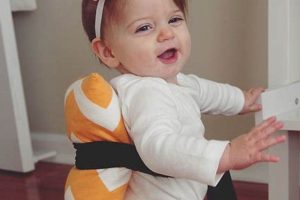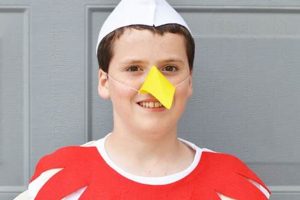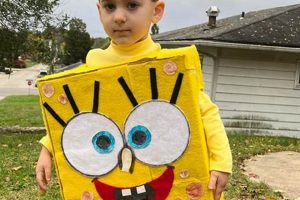Creating a Bowser costume through do-it-yourself methods involves the construction of attire that replicates the appearance of the iconic video game antagonist. This undertaking typically includes crafting a shell, headpiece with horns, and other distinctive features of the character using various materials and techniques. For example, individuals may utilize foam, fabric, and paint to realize their desired Bowser aesthetic.
The appeal of constructing such a costume lies in its potential for cost-effectiveness and personalization. Rather than purchasing a pre-made costume, individuals can tailor the design and materials to fit their specific needs and preferences, often resulting in a more unique and high-quality final product. Historically, this approach has been favored by cosplayers and individuals seeking creative expression for events like Halloween or conventions.
The following sections will explore the materials, construction methods, and design considerations necessary for a successful homemade Bowser ensemble. Detailed instructions and tips will be provided to guide readers through the process of creating a compelling and recognizable representation of the character.
Bowser DIY Costume
Constructing a recognizable and durable Bowser costume requires careful planning and execution. The following tips provide guidance for crafting a superior homemade rendition of the character.
Tip 1: Material Selection is Critical. Prioritize durable yet lightweight materials for the shell. EVA foam offers a balance between structural integrity and ease of manipulation. Consider the weight distribution early in the construction process to ensure comfort during wear.
Tip 2: Prioritize Accurate Proportions. Bowser’s silhouette is defined by specific proportions. Reference character art to accurately replicate the shell’s size relative to the body and the size of the horns relative to the head. Scale drawings can aid in achieving accuracy.
Tip 3: Implement a Robust Support System. The shell’s size and weight necessitate a secure support system. A harness or frame worn underneath the costume can effectively distribute the load, preventing discomfort and ensuring stability.
Tip 4: Focus on Detailing for Visual Impact. Bowsers distinctive features, such as the spikes on the shell and the texture of his skin, are crucial for recognition. Employ texturing techniques, such as dry brushing and scoring, to enhance the realism of the costume.
Tip 5: Secure Fastenings are Essential. Ensure that all costume components are securely fastened to prevent accidental detachment. Utilize heavy-duty velcro, straps, and buckles, paying particular attention to areas subject to high stress.
Tip 6: Consider Ventilation. Bowser costumes can become quite warm, particularly during extended wear. Incorporate ventilation into the design, such as hidden vents or breathable materials, to mitigate heat buildup and improve wearer comfort.
Tip 7: Plan for Maneuverability. The costume’s bulk can restrict movement. Design the costume to allow for a reasonable range of motion, particularly in the arms and legs. Consider the wearer’s ability to navigate doorways and staircases.
These tips emphasize the importance of planning, material selection, structural integrity, and attention to detail in achieving a successful homemade Bowser costume. By adhering to these guidelines, individuals can create a visually impressive and functional representation of the character.
The subsequent sections will delve into specific construction techniques and design choices to further refine the Bowser costume creation process.
1. Construction materials
The selection of construction materials forms the foundational element of any “bowser diy costume” endeavor. The properties of these materials directly influence the structural integrity, aesthetic realism, and overall wearability of the final product. Inadequate material choices can result in a costume that is either structurally unsound, visually unconvincing, or excessively uncomfortable for the wearer. For instance, using cardboard as the primary material for the shell, while inexpensive, will likely yield a fragile and easily damaged structure, unsuitable for prolonged wear or rigorous activity. Conversely, employing rigid fiberglass could create a durable shell but introduce significant weight and potential safety hazards.
Consider the shell, a defining characteristic of Bowser’s appearance. EVA foam, a closed-cell foam, is often chosen for its relative light weight, ease of shaping, and ability to hold detail. This material allows for the creation of a visually appealing and relatively durable shell without imposing excessive strain on the wearer. Similarly, the choice of materials for the hornsranging from lightweight foams to more rigid plasticsaffects both the aesthetic accuracy and the safety of the costume. Improperly secured or excessively heavy horns can pose a risk of injury. Furthermore, fabric choices for the body suit contribute to the overall comfort and breathability of the costume, influencing the wearer’s ability to tolerate extended periods of use.
In summary, the selection of construction materials for a “bowser diy costume” is a critical determinant of its success. A thorough understanding of material properties, coupled with careful consideration of structural requirements, aesthetic goals, and safety concerns, is essential for creating a costume that is both visually impressive and functionally sound. The appropriate selection of materials directly translates to an enhanced wearer experience and an increased likelihood of achieving a satisfactory representation of the character.
2. Shell design
Shell design constitutes a pivotal element within any “bowser diy costume” project. The accuracy and quality of the shell directly correlate with the overall recognizability and impact of the costume. A poorly designed shell, regardless of other details, detracts significantly from the illusion of portraying the character. Cause and effect are readily apparent: imprecise measurements lead to an ill-fitting shell; inferior construction compromises structural integrity. For example, a shell constructed without proper curvature and spiky detail, despite using appropriate materials, may resemble an amorphous mass rather than Bowser’s signature carapace. Its importance lies in being the most visually defining feature, overshadowing other costume components.
Practical applications stemming from a strong understanding of shell design include enhanced costume durability and improved wearer comfort. A well-engineered shell evenly distributes weight, reducing strain on the wearer. Furthermore, accurate scaling allows for unimpeded movement, preventing the costume from becoming unwieldy. As an example, designing a segmented shell allows for greater flexibility at the torso, enabling a wider ran
ge of motion than a single, rigid form. Similarly, incorporating internal support structures reinforces the shell against deformation, extending its lifespan. Attention to these factors contributes to a more enjoyable and authentic cosplay experience.
In summary, shell design plays a crucial role in the success of a “bowser diy costume.” Precise execution in scaling, construction, and detailing are essential to accurately replicate Bowser’s iconic form. Overlooking this component diminishes the impact of the entire costume. While challenges exist in achieving accurate curvature and structural stability, focusing on these factors yields a more recognizable, durable, and comfortable end product. Proper shell construction not only enhances the costume’s appearance but also contributes to the wearer’s ability to embody the character effectively.
3. Horn fabrication
Horn fabrication is an indispensable aspect of any comprehensive “bowser diy costume.” The horns, prominently positioned on the character’s head, contribute significantly to the overall visual impact and immediate recognizability of the costume. Their size, shape, texture, and method of attachment are all critical considerations that influence the perceived quality and authenticity of the portrayal. The omission of properly fabricated horns, or the use of poorly constructed ones, can substantially detract from the costume’s success. A direct cause and effect relationship exists between the attention dedicated to horn fabrication and the overall effectiveness of the Bowser representation. For example, utilizing lightweight expanding foam sculpted and hardened with epoxy resin, followed by detailed painting, yields a more realistic appearance compared to simple cardboard cutouts. The latter, while expedient, compromises the visual fidelity necessary for a convincing portrayal.
The practical significance of understanding horn fabrication techniques extends beyond mere aesthetics. A secure and comfortable attachment system is paramount to prevent the horns from detaching during wear or causing discomfort to the wearer. Examples include employing internal headbands or helmet liners to distribute weight evenly and prevent chafing. Furthermore, the chosen materials must balance realism with safety. Rigid materials, while potentially more durable, pose a risk of injury in crowded environments or during physical activity. Flexible, impact-absorbing materials provide a safer alternative without necessarily sacrificing visual appeal. Applying these principles allows for the creation of horns that are both visually striking and functionally sound. This understanding translates directly into enhanced wearer comfort and confidence, as well as improved overall costume durability.
In summary, horn fabrication is not merely a decorative element but a vital component of a successful “bowser diy costume.” Its importance stems from its significant contribution to visual recognition and the need for a secure and comfortable attachment. While challenges exist in balancing aesthetic accuracy with practical considerations like safety and wearability, meticulous attention to detail in material selection, construction techniques, and attachment methods yields a superior final product. By prioritizing these factors, the costume creator can significantly enhance the overall impact and realism of their Bowser representation.
4. Comfort, wearability
The aspects of comfort and wearability are paramount when undertaking a “bowser diy costume” project. A visually impressive costume is rendered impractical if it inhibits movement, causes discomfort, or presents safety hazards during extended wear. The integration of these considerations directly impacts the user experience and the overall success of the costume endeavor.
- Weight Distribution and Support
The considerable size and bulk associated with Bowser’s design necessitate careful weight distribution. Imbalances can lead to strain on specific muscle groups, causing fatigue and discomfort. Implementing a robust support system, such as a harness or internal frame, evenly distributes the weight across the torso and shoulders. This preventative measure allows for extended periods of wear without undue physical stress.
- Ventilation and Temperature Regulation
Enclosed costumes can rapidly accumulate heat, leading to discomfort and potential health risks. Incorporating ventilation systems, such as strategically placed vents or breathable fabrics, mitigates heat buildup. Selection of materials that promote airflow is crucial for maintaining a comfortable internal temperature, especially during prolonged activity or in warm environments.
- Range of Motion and Agility
The design of a Bowser costume should not unduly restrict the wearer’s range of motion. Limited mobility can hinder basic actions and increase the risk of accidents. Careful articulation of joints and flexible material selection in key areas, such as the arms and legs, allows for a greater degree of agility and freedom of movement. This improves both the wearer’s comfort and safety.
- Material Selection and Skin Irritation
Direct contact between the costume and the skin can lead to irritation and discomfort if inappropriate materials are used. Opting for hypoallergenic and breathable fabrics, particularly in areas of prolonged skin contact, minimizes the risk of adverse reactions. Smooth, non-abrasive surfaces also prevent chafing and skin irritation, enhancing the overall wearing experience.
Integrating these comfort and wearability considerations into the design and construction of a “bowser diy costume” is crucial for ensuring a positive experience. A well-designed costume prioritizes both visual accuracy and practical functionality, allowing the wearer to fully embody the character without compromising their physical well-being. Addressing these factors enhances the longevity and enjoyment of the costume, promoting its repeated use and maximizing its value.
5. Paint, texture
The application of paint and texture represents a critical phase in the creation of any “bowser diy costume.” The perceived realism and overall impact of the costume hinges significantly on the successful execution of these finishing touches. A poorly painted or inadequately textured costume, irrespective of the structural integrity of its components, will fail to convincingly portray the character. The correlation between meticulous painting and texturing techniques and the final aesthetic outcome is demonstrably causal. For instance, a smooth, untextured surface, even if appropriately colored, lacks the visual depth and organic quality associated with Bowser’s reptilian skin. Conversely, the strategic application of dry brushing, stippling, or other texturing methods can simulate scales, wrinkles, and other surface irregularities, thereby enhancing the costume’s authenticity.
Practical applications of this understanding are multifaceted. Proper surface preparation, including priming and sealing, ensures optimal paint adhesion and prevents premature chipping or cracking. The selection of appropriate paint types, such as acrylics or
flexible coatings, accounts for the material properties of the underlying substrate. Utilizing multiple layers of paint, each with varying degrees of transparency or reflectivity, creates visual depth and simulates subsurface scattering. The deliberate introduction of imperfections, such as subtle variations in color or texture, further contributes to the illusion of realism. Examples include using washes to accentuate crevices, stencils to replicate scale patterns, or specialized paints to create a metallic or iridescent sheen. These techniques, while requiring skill and attention to detail, yield a substantial improvement in the costume’s visual impact.
In summary, paint and texture are not merely cosmetic additions but integral components of a successful “bowser diy costume.” The meticulous application of these finishing touches can transform a rudimentary structure into a convincing representation of the character. While challenges exist in achieving realistic textures and accurate color palettes, the effort invested in mastering these techniques directly translates into a more visually compelling and authentic final product. The ability to effectively manipulate paint and texture is essential for creating a Bowser costume that captures the essence of the character and commands attention.
6. Budget considerations
Budget considerations are intrinsically linked to the creation of a “bowser diy costume,” shaping the scope, materials, and construction techniques employed. Financial constraints directly influence design choices, impacting the final product’s visual fidelity and durability.
- Material Selection and Cost
The availability of funds dictates the materials employed. High-end materials like professional-grade EVA foam or specialized paints enhance realism and longevity but incur higher costs. Budgetary limitations may necessitate the use of less expensive alternatives, such as craft foam or acrylic paints, potentially compromising the final aesthetic. Resourcefulness in sourcing materials, like repurposing existing items, can mitigate expenses.
- Complexity of Design and Labor
Intricate designs featuring detailed textures and complex shapes demand considerable time and skill. Professional fabrication services offer expertise but come at a premium. Individuals operating within constrained budgets may opt for simplified designs to reduce labor costs and construction time. The trade-off involves sacrificing intricate details for affordability.
- Tool Acquisition and Accessibility
Specialized tools, such as heat guns, rotary tools, and sewing machines, facilitate precise construction and professional finishes. The purchase or rental of these tools represents a significant expense. Limited budgets may necessitate reliance on simpler, manual tools or the sharing of resources with other costume enthusiasts, potentially extending the construction timeline.
- Time Investment and Opportunity Cost
Creating a “bowser diy costume” is a time-intensive endeavor. Individuals with limited financial resources may dedicate more time to sourcing affordable materials and employing labor-intensive construction methods. The value of this time, or the opportunity cost, should be considered. Balancing time investment with other commitments is crucial for maintaining project feasibility.
These budget considerations highlight the inherent trade-offs in crafting a “bowser diy costume.” While financial limitations necessitate creative problem-solving and resourcefulness, careful planning and prioritization can yield impressive results. Balancing cost-effectiveness with desired aesthetic outcomes is essential for achieving a successful and satisfying project.
Frequently Asked Questions
The following questions address common inquiries and concerns regarding the creation of a do-it-yourself Bowser costume. These responses aim to provide clear and concise information to assist individuals in their costume construction efforts.
Question 1: What is the estimated cost for constructing a Bowser DIY costume?
The cost varies significantly depending on material choices and the complexity of the design. A basic costume utilizing readily available craft materials may range from $50 to $150. More elaborate designs employing professional-grade materials and specialized techniques can exceed $300.
Question 2: What tools are essential for crafting a Bowser DIY costume?
Essential tools typically include a hot glue gun, utility knife, scissors, measuring tape, and a cutting surface. Depending on the complexity, additional tools such as a sewing machine, rotary tool, heat gun, and airbrush may be required.
Question 3: What is the most durable material for the Bowser shell?
EVA foam is generally considered the most durable and versatile material for the shell. Its flexibility, ease of shaping, and ability to withstand impacts make it a suitable choice for costume construction.
Question 4: How can the wearer ensure adequate ventilation within the costume?
Ventilation can be improved by incorporating strategically placed mesh panels or vents within the costume. Selecting breathable fabrics for the under layers and avoiding excessive insulation also aids in temperature regulation.
Question 5: What are the most common challenges encountered during Bowser costume construction?
Common challenges include achieving accurate proportions, ensuring structural stability of the shell, and managing the weight distribution of the costume. Securing the horns and spikes without causing discomfort is another frequent obstacle.
Question 6: How can individuals ensure the longevity of their Bowser DIY costume?
Proper storage, gentle handling, and periodic maintenance are crucial for preserving the costume’s integrity. Protecting the costume from excessive moisture and direct sunlight, and promptly repairing any damage, will extend its lifespan.
These FAQs address key considerations for individuals embarking on a Bowser DIY costume project. Careful planning, material selection, and construction techniques are essential for achieving a successful and durable final product.
The subsequent section will provide resources for further exploration and inspiration related to Bowser costume design and construction.
Conclusion
The preceding analysis has explored various facets of the “bowser diy costume,” emphasizing critical considerations for successful creation. Material selection, shell design, horn fabrication, comfort, paint, texture, and budget have been examined in detail. The synthesis of these elements dictates the ultimate quality and wearability of the finished product. The pursuit of accuracy in representation necessitates a balanced approach, weighing aesthetic fidelity against practical constraints.
The enduring appeal of character embodiment through homemade attire suggests a continued interest in projects of this nature. Individuals embarking on the construction of a “bowser diy costume” should approach the undertaking with thorough planning, attention to detail, and a commitment to balancing creative vision with practical limitations. The result, when executed effectively, represents not only a costume, but also a testament to craftsmanship and creative expression.







